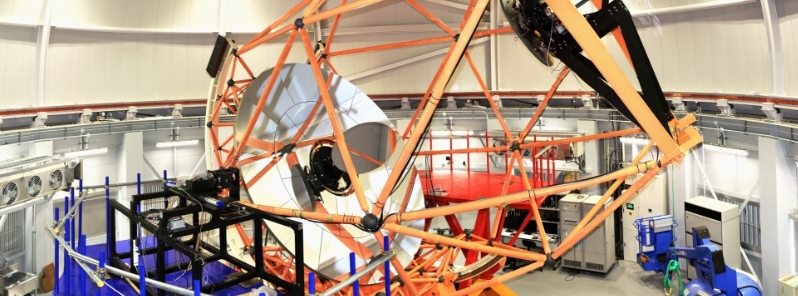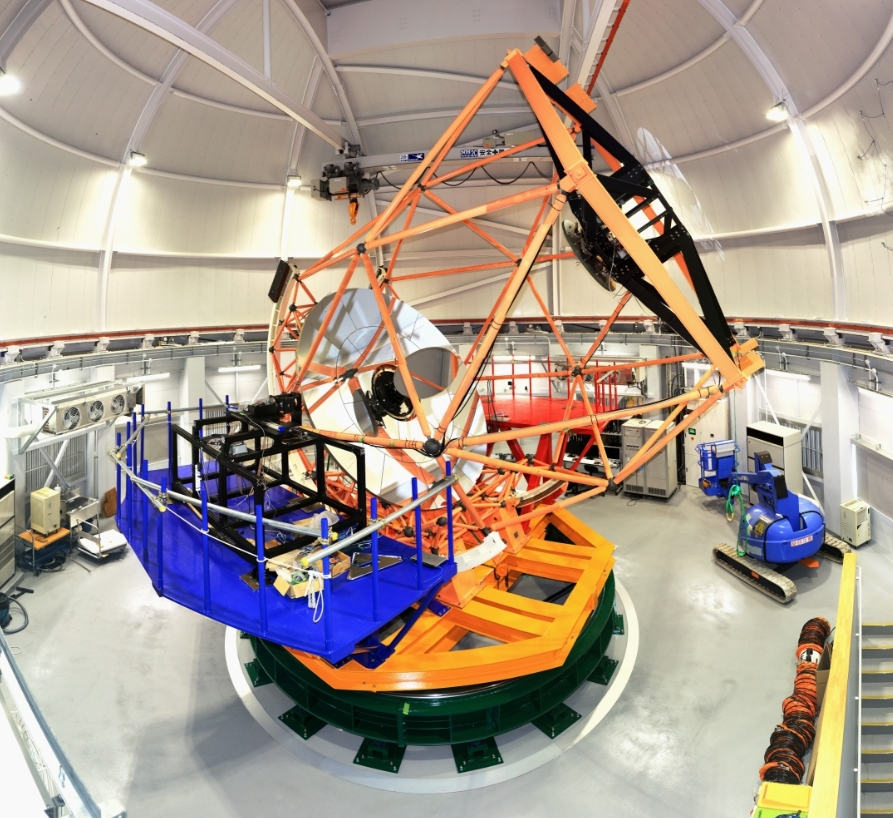Seimei telescope detects superflare 20 times larger than those emitted by our own sun

Astronomers from Kyoto University's Graduate School of Science and the National Astronomical Observatory of Japan have succeeded in detecting 12 stellar flare phenomena on a red dwarf 16 light-years away using the 3.8 meter Seimei telescope. This new instrument was able to spot one of the flares that was 20 times larger than those emitted by the Sun, and researchers said more information on these stellar phenomena may help predict superflares and possibly mitigate magnetic storm damage on Earth.
The instrument, located on a hilltop in Okayama to the west of Kyoto, detected the phenomena on AD Leonis– a red dwarf 6 light-years away.
"Solar flares are sudden explosions that emanate from the surfaces of stars, including our own Sun," said co-author Kosuke Namekata.
"On rare occasions, an extremely large superflare will occur. These result in massive magnetic storms, which when emitted from our sun can significantly affect the earth's technological infrastructure."
Understanding the properties of superflares can be important, but their rareness indicates that data from the Sun is difficult to gather. This has led researchers to search for exoplanets similar to the Earth and to study the stars they orbit.

Image credit: Kyoto University
The team reported on a long week of setting the sights of Seimei telescope, along with other observational facilities, to AD Leonis. The dwarf has temperatures lower than that of the Sun, which results in a high occurrence of flares.
"Our analyses of the superflare resulted in some very intriguing data," said Namekata.
Light from excited hydrogen atoms of the superflare displayed a number of high-energy electrons about one order of magnitude greater than usual flares from the Sun.
"It's the first time this phenomenon has been reported, and it's thanks to the high precision of the Seimei Telescope."
The team also observed flares where light from excited hydrogen atoms increased but did not correspond with an increase in brightness across the rest of the observable spectrum.
"This was new for us as well, because typical flare studies have observed the continuum of the light spectrum– the broad range of wavelengths– rather than energy coming from specific atoms."
The new telescope was able to provide such high-quality data, and the team hopes it will open opportunities for new revelations on extreme space events.
"More information on these fundamental stellar phenomena will help us predict superflares, and possibly mitigate magnetic storm damage here on earth," lead author Kazunari Shibata concluded.
"We may even be able to begin understanding how these emissions can affect the existence– or emergence– of life on other planets."
Reference
"Optical and X-ray observations of stellar flares on an active M dwarf AD Leonis with the Seimei Telescope, SCAT, NICER, and OISTER – Namekta, K. et al. – Publications of the Astronomical Society of Japan – https://doi.org/10.1093/pasj/psaa051
Abstract
We report on multi-wavelength monitoring observations of an M-dwarf flare star AD Leonis with the Seimei Telescope (6150–7930 Å), SCAT (Spectroscopic Chuo-university Astronomical Telescope; 3700–7500 Å), and NICER (Neutron Star Interior Composition Explorer; 0.2–12.0 keV), with the collaboration of the OISTER (Optical and Infrared Synergetic Telescopes for Education and Research) program. Twelve flares are detected in total, including ten Hα, four X-ray, and four optical-continuum flares; one of them is a superflare with a total energy of ∼2.0 × 1033 erg. We found that: (1) during the superflare, the Hα emission line full width at 1/8 maximum dramatically increases to 14 Å from 8 Å in the low-resolution spectra (R ∼ 2000) accompanied by large white-light flares, (2) some weak Hα/X-ray flares are not accompanied by white-light emissions, and (3) the non-flaring emissions show clear rotational modulations in X-ray and Hα intensity in the same phase. To understand these observational features, one-dimensional hydrodynamic flare simulations are performed using the RADYN code. We find the simulated Hα line profiles with hard and high-energy non-thermal electron beams to be consistent with the initial phase line profiles of the superflares, while those with a softer and/or weak-energy beam are consistent with those in decay phases, indicating the changes in the energy fluxes injected to the lower atmosphere. Also, we find that the relation between the optical continuum and Hα intensity is nonlinear, which can be one cause of the non-white-light flares. The flare energy budget exhibits diversity in the observations and models, and more observations of stellar flares are necessary for constraining the occurrence of various emission line phenomena in stellar flares.
Featured image credit: Kyoto University

Commenting rules and guidelines
We value the thoughts and opinions of our readers and welcome healthy discussions on our website. In order to maintain a respectful and positive community, we ask that all commenters follow these rules.